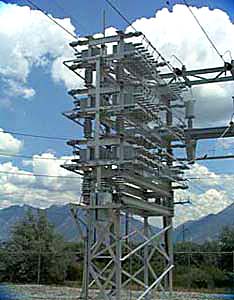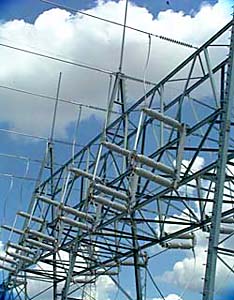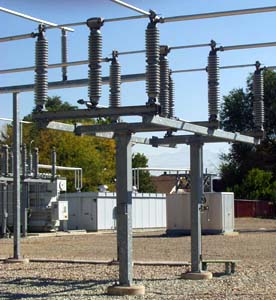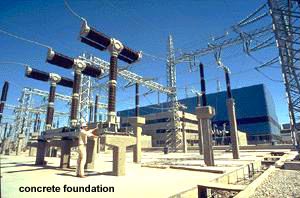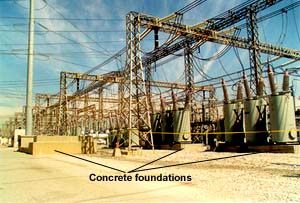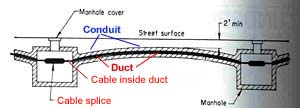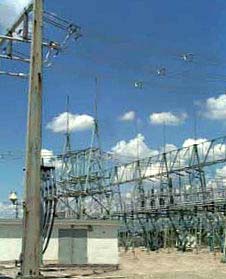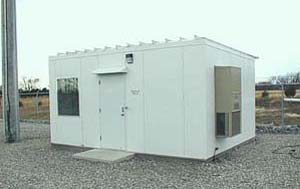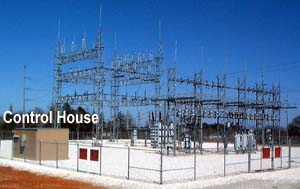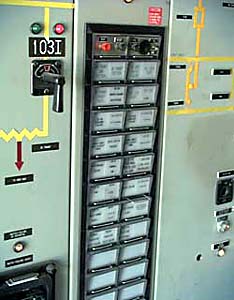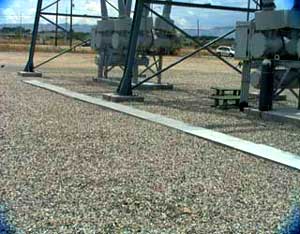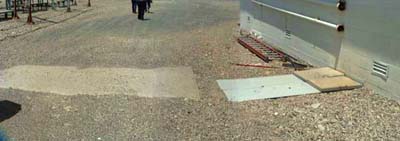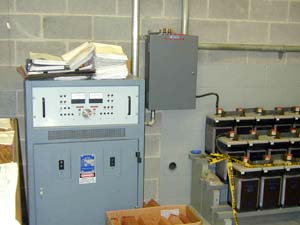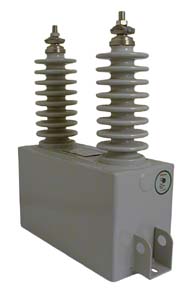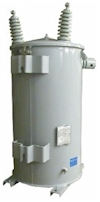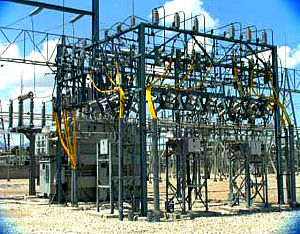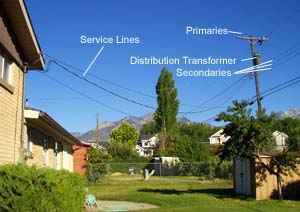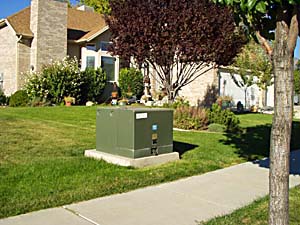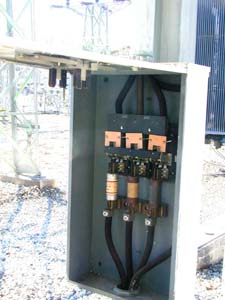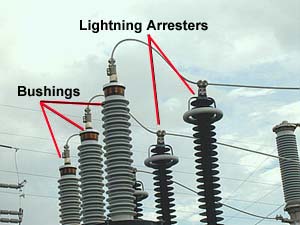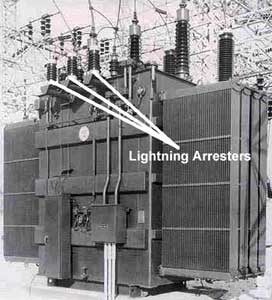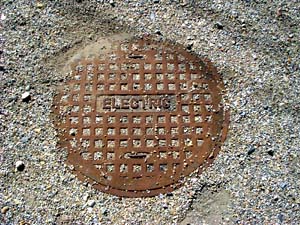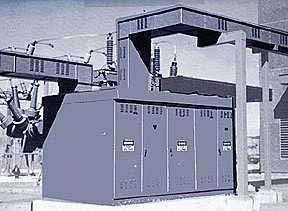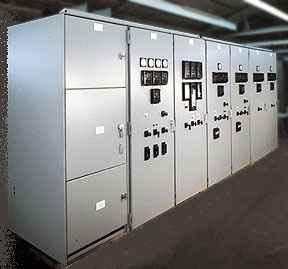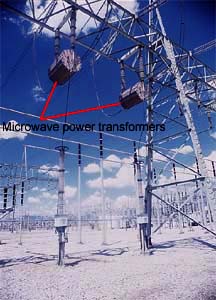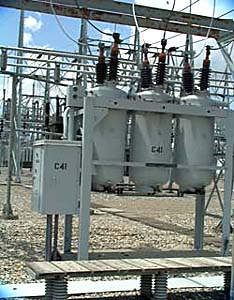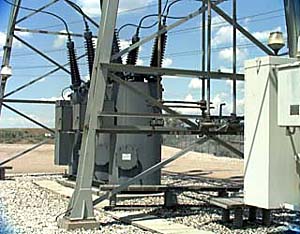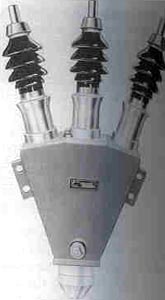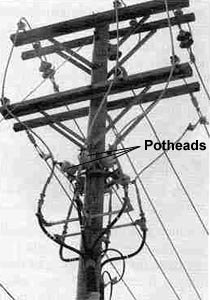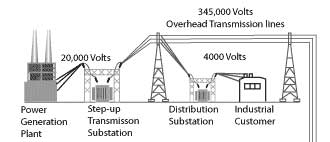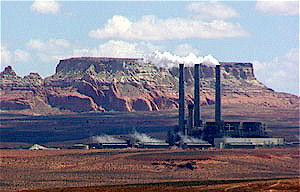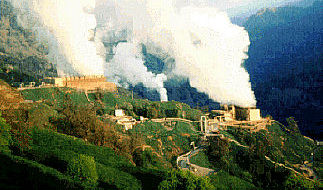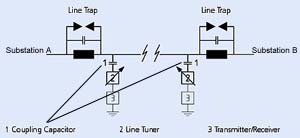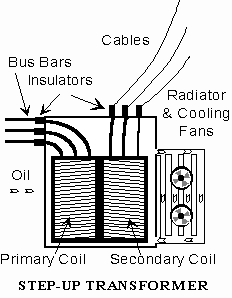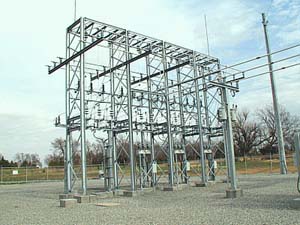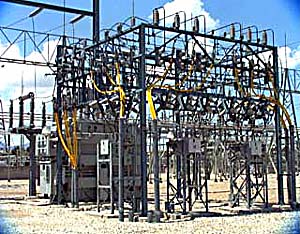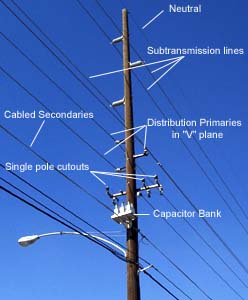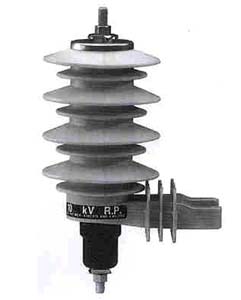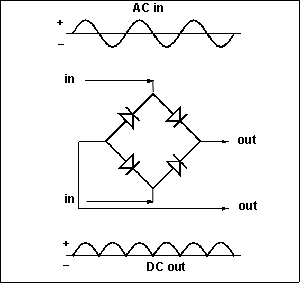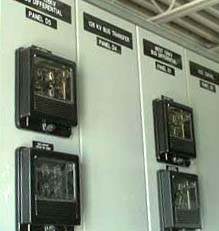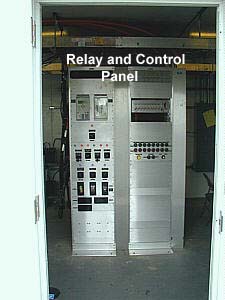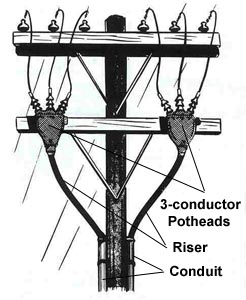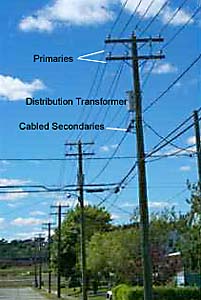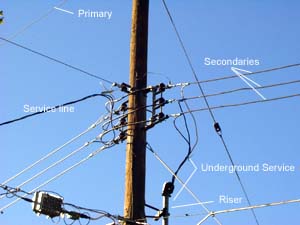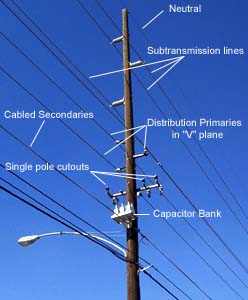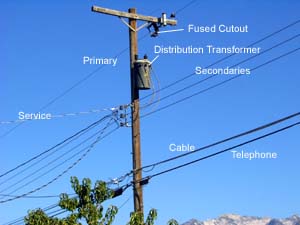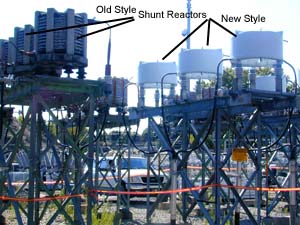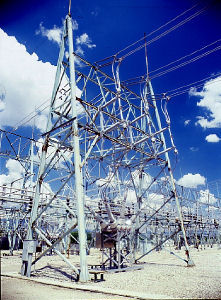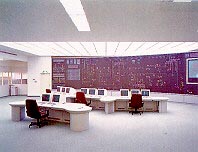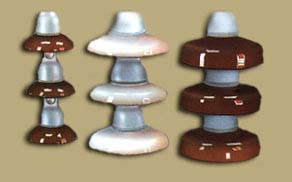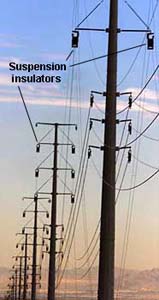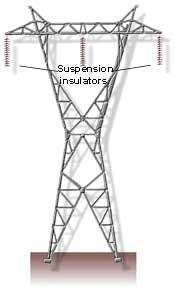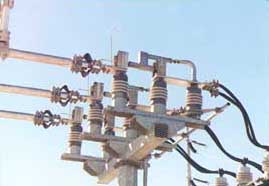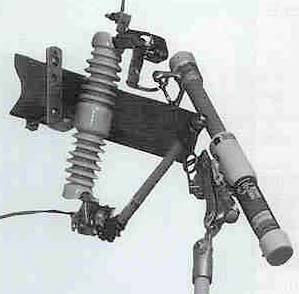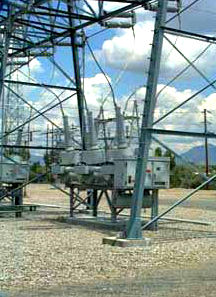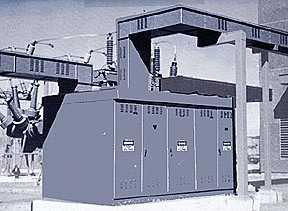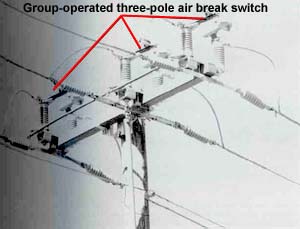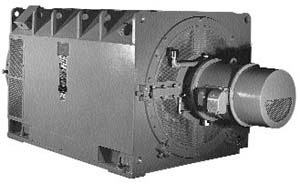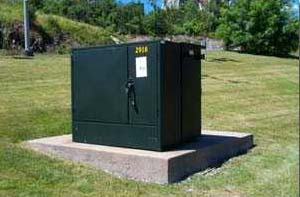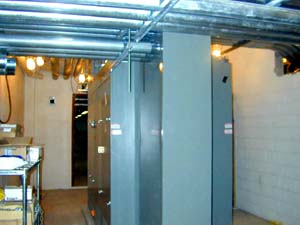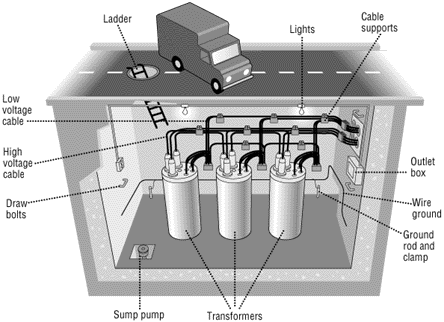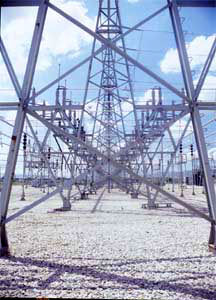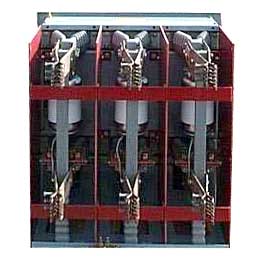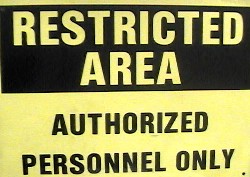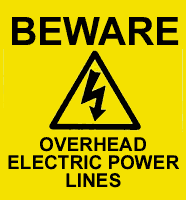Electric Power Generation, Transmission, and Distribution eTool
Electric Power Generation, Transmission, and Distribution » Glossary of Terms
A
Absorber: A material that readily absorbs photons to generate charge carriers (free electrons or holes).
Absorbers: Dark-colored objects that soak up heat in solar collectors.
Absorption coefficient: The factor by which photons are absorbed as they travel a unit distance through a material.
Acceptor: A dopant material, such as boron, which has fewer outer shell electrons than required in an otherwise balanced crystal structure, providing a hole, which can accept a free electron.
Accessible: (As applied to wiring methods) Capable of being removed or exposed without damaging the building structure or finish, or not permanently closed in by the structure or finish of the building.
Accessible: (as applied to equipment) Admitting close approach: not guarded by locked doors, elevation, or other effective means. (see Accessible, Readily)
Accessible, Readily: (Readily Accessible) Capable of being reached quickly for operation, renewal, or inspections, without requiring those to whom ready access is requisite to climb over or remove obstacles or to resort to portable ladders, chairs, etc.
Actinide: an element with atomic number of 89 (actinium) or above.
Activation product: A radioactive isotope of an element (e.g., in the steel of a reactor core) which has been created by neutron bombardment.
Active solar heater: A solar water or space-heating system that moves heated air or water using pumps or fans.
Affected employee: An employee whose job requires him or her to operate or use a machine or equipment on which servicing or maintenance is being performed under lockout or tagout, or whose job requires him or her to work in an area in which such servicing or maintenance is being performed.
Air mass: The ratio of the mass of atmosphere in the actual observer-sun path to the mass that would exist if the observer was at sea level, at standard barometric pressure, and the sun was directly overhead. Note: (sometimes called air mass ratio).
Air mass 1.5 (AM1.5) standard reference spectrum: The solar spectral irradiance distribution (diffuse and direct) incident at sea level on a sun-facing 37-degree tilted surface. The atmospheric conditions for AM1.5 are: precipitable water vapor, 14.2 mm; total ozone, 3.4 mm; turbidity (base e, lambda=0.5 mm), 0.27. [ASTM E 892, Table 2]
Alternating current: Electric current in which the direction of flow is reversed at frequent intervals: usually 100 or 120 times per second (50 or 60 cycles per second or 50//60 Hz).
ALARA: As Low As Reasonably Achievable, economic and social factors being taken into account. This is the optimization principle of radiation protection.
Alpha particle: A positively-charged particle from the nucleus of an atom, emitted during radioactive decay. Alpha particles are helium nuclei, with 2 protons and 2 neutrons.
Alternative fuels: Solid fuels such as municipal solid waste (MSW), refuse derived fuel (RDF), biomass, rubber tires, and other combustibles that are used instead of fossil fuels (gas, oil, or coal) in a boiler to produce steam for the generation of electrical energy.
Ambient Temperature: The temperature of the air, water, or surrounding earth. Conductor ampacity is corrected for changes in ambient temperature including temperatures below 86°F. The cooling effect can increase the current carrying capacity of the conductor. (Review Section 310-10 f the Electrical Code for more understanding)
Ammeter: An electric meter used to measure current, calibrated in amperes.
Ampacity: The current-carrying capacity of conductors or equipment, expressed in amperes.
Ampere (A) or amp: The basic SI unit measuring the quantity of electricity. The unit for the electric current; the flow of electrons. One amp is 1 coulomb passing in one second. One amp is produced by an electric force of 1 volt acting across a resistance of 1 ohm.
Ampere-hour (Ah): Quantity of electricity or measure of charge. (1 Ah = 3600 C [Coulomb])
Amorphous semiconductor: A non-crystalline semiconductor material that has no long-range order.
Annual solar savings: The annual solar savings of a solar building is the energy savings attributable to a solar feature relative to the energy requirements of a non-solar building.
Anthropogenic: Referring to alterations in the environment due to the presence or activities of humans.
Antireflection coating: A thin coating of a material, which reduces the light reflection and increases light transmission, applied to a photovoltaic cell surface.
Armored Cable: A cable provided with a wrapping of metal, usually steel wires or tapes, primarily for the purpose of mechanical protection.
Arc-over Voltage: The minimum voltage required to cause an arc between electrodes separated by a gas or liquid insulation.
Array: Any number of photovoltaic modules connected together to provide a single electrical output. Arrays are often designed to produce significant amounts of electricity.
Atom: A particle of matter which cannot be broken up by chemical means. Atoms have a nucleus consisting of positively-charged protons and uncharged neutrons of the same mass. The positive charges on the protons are balanced by a number of negatively-charged electrons in motion around the nucleus.
Attendant: An employee assigned to remain immediately outside the entrance to an enclosed or other space to render assistance as needed to employees inside the space.
Attenuation: (l) The ratio of the input to output power levels in a network (transmission line) when it is excited by a matched source and terminated in a matched load. (2) Power loss in an electrical system.
Authorized employee: An employee who locks out or tags out machines or equipment in order to perform servicing or maintenance on that machine or equipment. An affected employee becomes an authorized employee when that employee's duties include performing servicing or maintenance covered under this section.
Automatic circuit re-closer: A self-controlleddevice for interrupting and re-closing an alternating current circuit with a predetermined sequence of opening and re-closing followed by resetting, hold-closed, or lockout operation.
Autonomous system: A stand-alone Photovoltaic system that has no back-up generating source. May or may not include storage batteries.
Availability: Describes the reliability of power plants. It refers to the number of hours the turbines are available to produce power divided by the total hours in a year.
Avoided cost: The minimum amount an electric utility is required to pay an independent power producer, under the PURPA regulations of 1978, equal to the costs the utility calculates it avoids in not having to produce that power (usually substantially less than the retail price charged by the utility for power it sells to customers).
B
Background radiation: The naturally-occurring ionizing radiation which every person is exposed to, arising from the earth's crust (including radon) and from cosmic radiation.
Balance of system: Represents all components and costs other than the Photovoltaic modules. It includes design costs, land, site preparation, system installation, support structures, power conditioning, operation and maintenance costs, indirect storage, and related costs.
Band gap: In a semiconductor, the energy difference between the highest valence band and the lowest conduction band.
Band gap energy (EG): The amount of energy (in electron volts) required to free an outer shell electron from its orbit about the nucleus to a free state and, thus, to promote it from the valence level to the conduction level.
Band-to-band Auger recombination: Recombination of an electron and a hole occurring between bands of the same energy in which no magnetic radiation is emitted.
Bare Conductor: A conductor not covered with insulating material.
Barricade: A physical obstruction such as tapes, cones, or A-frame type wood or metal structures intended to provide a warning about and to limit access to a hazardous area.
Barrier: A physical obstruction which is intended to prevent contact with energized lines or equipment or to prevent unauthorized access to a work area.
Barrier energy: The energy given up by an electron in penetrating the cell barrier; a measure of the electrostatic potential of the barrier.
Barrier, fire: A continuous membrane, either vertical or horizontal, such as a wall or floor assembly, that is designed and constructed with specified fire resistance rating to limit the spread of fire and that will also restrict the movement of smoke. Such barriers can have protected openings.
Base load: That part of electricity demand which is continuous, and does not vary over a 24-hour period. Approximately equivalent to the minimum daily load.
Base power: Power generated by a utility unit that operates at a very high capacity factor.
Baseline performance value: Initial values of short-circuit current, open-circuit voltage, and current at maximum power measured by the accredited laboratory and corrected to Standard Test Conditions, used to validate the manufacturer's performance measurements provided with the qualification modules per IEEE 1262.
Battery energy storage: The three main applications for battery energy storage systems include spinning reserve at generating stations, load leveling at substations, and peak shaving on the customer side of the meter. Battery storage has also been suggested for holding down air emissions at the power plant by shifting the time of day of the emission or shifting the location of emissions.
Bayonet Coupling: A quick coupling device for plug and receptacle connectors, accomplished by rotation of a cam operating device designed to bring the connector halves together.
Becquerel: The SI unit of intrinsic radioactivity in a material. One Bq measures one disintegration per second and is thus the activity of a quantity of radioactive material which averages one decay per second. (In practice, GBq or TBq are the common units.)
Beryllium Copper (BeCu): A relatively expensive contact material with properties superior to brass and phosphor bronze. It is recommended for contact applications requiring repeated extraction and reinsertion because of its resistance to fatigue at high operating temperatures.
Beta particle: A particle emitted from an atom during radioactive decay. Beta particles may be either electrons (with negative charge) or positrons.
BIPV (Building-Integrated Photovoltaic): A term for the design and integration of Photovoltaic into the building envelope, typically replacing conventional building materials. This integration may be in vertical facades, replacing view glass, spandrel glass, or other facade material; into semitransparent skylight systems; into roofing systems, replacing traditional roofing materials; into shading "eyebrows" over windows; or other building envelope systems.
Biological shield: A mass of absorbing material (e.g., thick concrete walls) placed around a reactor or radioactive material to reduce the radiation (especially neutrons and gamma rays respectively) to a level safe for humans.
Blocking diode: A diode used to restrict or block reverse current from flowing backward through a module. [UL 1703] Alternatively, diode connected in series to a Photovoltaic string; it protects its modules from a reverse power flow and, thus, against the risk of thermal destruction of solar cells.
Boiling water reactor (BWR): A common type of light water reactor (LWR), where water is allowed to boil in the core thus generating steam directly in the reactor vessel. (cf PWR)
Bonding Jumper: A bare or insulated conductor used to ensure the required electrical conductivity between metal parts required to be electrically connected. Frequently used from a bonding bushing to the service equipment enclosure to provide a path around concentric knockouts in an enclosure wall - also used to bond one raceway to another.
Boron (B): A chemical element, atomic number 5, semi-metallic in nature, used as a dopant to make p-semiconductor layers.
Boule: A sausage-shaped synthetic single-crystal mass grown in a special furnace, pulled and turned at a rate necessary to maintain the single-crystal structure during growth.
Breakdown Voltage: The voltage at which an insulator or dielectric ruptures, or at which ionization and conduction take place in a gas or vapor.
Breed: To form fissile nuclei, usually as a result of neutron capture, possibly followed by radioactive decay.
Breeder reactor: see Fast Breeder Reactor and Fast Neutron Reactor.
British thermal unit (Btu): The amount of heat energy required to raise the temperature of one pound of water from 60 degrees F to 61 degrees F at one atmosphere pressure.
Burnable poison: A neutron absorber included in the fuel which progressively disappears and compensates for the loss of reactivity as the fuel is consumed. Gadolinium is commonly used.
Burnup: Measure of thermal energy released by nuclear fuel relative to its mass, typically Gigawatt days per tonne (GWd/tU).
Bushing: An insulating structure, including a through conductor or providing a passageway for such a conductor, with provision for mounting on a barrier, conducting or otherwise, for the purposes of insulating the conductor from the barrier and conducting current from one side of the barrier to the other.

Bypass diode: A diode connected across one or more solar cells in a photovoltaic module such that the diode will conduct if the cell(s) become reverse biased. [UL 1703] Alternatively, diode connected anti-parallel across a part of the solar cells of a Photovoltaic module. It protects these solar cells from thermal destruction in case of total or partial shading of individual solar cells while other cells are exposed to full light.
C
Cable: A conductor with insulation, or a stranded conductor with or without insulation and other coverings (single-conductor cable), or a combination of conductors insulated from one another (multiple-conductor cable).
Cable Assembly: A cable with plugs or connectors on each end.
Cable sheath: A conductive protective covering applied to cables. Note: A cable sheath may consist of multiple layers of which one or more is conductive.
Cadmium (Cd): A chemical element, atomic number 48, used in making certain types of solar cells and batteries.
Cadmium telluride (CdTe): A polycrystalline thin-film photovoltaic material.
Calandria: (in a CANDU reactor) a cylindrical reactor vessel which contains the heavy water moderator. It is penetrated from end to end by hundreds of calandria tubes which accommodate the pressure tubes containing the fuel and coolant.
CANDU: Canadian deuterium uranium reactor, moderated and (usually) cooled by heavy water.
Capacitance: That property of a system of conductors and dielectrics that permits the storage of electricity when potential difference exists between the conductors. Its value is expressed as the ratio of quantity of electricity to a potential difference. A capacitance value is always positive.
Capacity factor: The amount of energy that the system produces at a particular site as a percentage of the total amount that it would produce if it operated at rated capacity during the entire year. For example, the capacity factor for a wind farm ranges from 20% to 35%. Thirty-five percent is close to the technology potential.
Cathodic protection: A method of preventing oxidation (rusting) of exposed metal structures, such as bridges and pipelines, by imposing between the structure and the ground a small electrical voltage that opposes the flow of electrons and that is greater than the voltage present during oxidation.
Cell: The basic unit of a photovoltaic system.
Cell barrier: A very thin region of static electric charge along the interface of the positive and negative layers in a photovoltaic cell. The barrier inhibits the movement of electrons from one layer to the other, so that higher-energy electrons from one side diffuse preferentially through it in one direction, creating a current and thus a voltage across the cell. Also called depletion zone, cell junction, or space charge.
Cell junction: The area of immediate contact between two layers (positive and negative) of a photovoltaic cell. The junction lies at the center of the cell barrier or depletion zone.
Central power: The generation of electricity in large power plants with distribution through a network of transmission lines (grid) for sale to a number of users. Opposite of distributed power.
Chain reaction: A reaction that stimulates its own repetition, in particular where the neutrons originating from nuclear fission cause an ongoing series of fission reactions.
Charge carrier: A free and mobile conduction electron or hole in a semiconductor.
Chemical vapor deposition (CVD): A method of depositing thin semiconductor films. With this method, a substrate is exposed to one or more vaporized compounds, one or more of which contain desirable constituents. A chemical reaction is initiated, at or near the substrate surface, to produce the desired material that will condense on the substrate.
Chlorofluorocarbon: A family of chemicals composed primarily of carbon, hydrogen, chlorine, and fluorine whose principal applications are that of refrigerants and industrial cleansers and whose principal drawback is the tendency to destroy the Earth's protective ozone layer.
Circuit: A conductor or system of conductors through which an electric current is intended to flow.
Cladding: The metal tubes containing oxide fuel pellets in a reactor core.
Clearance (between objects): The clear distance between two objects measured surface to surface.
Clearance (for work): Authorization to perform specified work or permission to enter a restricted area.
Cleavage of lateral epitaxial films for transfer (CLEFT): A process for making inexpensive GaAs photovoltaic cells in which a thin film of GaAs is grown atop a thick, single-crystal GaAs (or other suitable material) substrate and then is cleaved from the substrate and incorporated into a cell, allowing the substrate to be reused to grow more thin-film GaAs.
Closed Entry Contact: A female contact designed to prevent the entry of a pin or probing device having a cross-sectional dimension (diameter) greater than the mating pin.
Coal: A black, solid fossil fuel found in the Earth. Coal is often burned to make electricity.
Coaxial Cable: A high-band width cable consisting of two concentric cylindrical conductors with a common axis that is used for high-speed data communication and video signals.
Cogeneration: The process in which fuel is used to produce heat for a boiler-steam turbine or gas for a turbine. The turbine drives a generator that produces electricity, with the excess heat used for process steam.
Combined collector: A photovoltaic device or module that provides useful heat energy in addition to electricity.
Compact fluorescent lights: Lights that use a lot less energy than regular light bulbs. We can use compact fluorescent lights for reading lights and ceiling lights.
Component Lead: The solid or stranded wire or formed conductor that extends from a component and serves as a readily formable mechanical or electrical connection or both.
Compressed-air energy storage (CAES): CAES plants use off-peak electrical energy to compress air into underground storage reservoirs for storage until times of peak or intermediate electricity demand. Wind power offers a good opportunity for charging CAES storage. The storage is typically underground in natural aquifers, depleted oil or gas fields, mined salt caverns, or excavated or natural rock caverns. To generate power, the compressed air is first heated by gas burners, then passed through a turbine.
Concentrator: A Photovoltaic module that uses optical elements to increase the amount of sunlight incident on a Photovoltaic cell.
Concentrating: arrays must track the sun and use only the direct sunlight because the diffuse portion cannot be focused onto the Photovoltaic cells.
Concentrate: See Uranium oxide concentrate (U3O8).
Concentrator (module, array, or collector): An arrangement of photovoltaic cells that includes a lens to concentrate sunlight onto small-area cells. Concentrators can increase the power flux of sunlight hundreds of times.
Concentricity: In a wire or cable, the measurement of the location of the center of the conductor with respect to the geometric center of the surrounding insulation.
Conductance: The reciprocal of resistance. It is the ratio of current passing through a material to the potential difference at its ends.
Conduction band; Conduction level: Energy level at which electrons are not bound to (orbiting) a specific atomic nucleus but are free to wander among the atoms. An energy band in which electrons can move freely in a solid, producing a net transport of charge.
Conductivity: The ability of a material to conduct electric current. It is expressed in terms of the current per unit of applied voltage. It is the reciprocal of resistivity.
Conductor: A wire or combination of wires not insulated from one another, suitable for carrying electric current.
Connection: That part of a circuit that has negligible impedance and that joins components, devices, etc., together.
Connector: A device providing electrical connection/disconnections. It consists of a mating plug and receptacle. Various types of connectors include DIP, card edge, two-piece, hermaphroditic and wire-wrapping configurations. Multiple contact connectors join two or more conductors with others in one mechanical assembly.
Connector Discontinuity: An ohmic change in contact resistance.
Connector Insert: For connectors with metal shells, the insert holds contacts in proper arrangement while electrically insulating them from each other and from the shell.
Connector Shell: The case that encloses the connector insert and contact assembly. Shells of mating connectors can protect projecting contacts and provide proper alignment.
Constant-speed wind turbines: Turbines that operate at a constant rotor revolutions per minute (RPM) and are optimized for energy capture at a given rotor diameter at a particular speed in the wind power curve.
Contact, Female: A contact located in an insert or body in such a manner that the mating contact is inserted into the unit. It is similar in function to a socket contact.
Contact, Male: A contact located in an insert or body in such a manner that the mating portion extends into the female contact. It is similar in function to a pin contact.
Contact Plating: Plated-on metal applied to the base contact metal to provide the required contact resistance and/or wear resistance.
Contact Resistance: Maximum permitted electrical resistance of pin and socket contacts when assembled in a connector under typical service use.
Contact Retainer: A device either on the contact or in the insert to retain the contact.
Contact Size: Defines the largest size wire that can be used with the specific contact. By specification dimensioning, it also defines the diameter of the engagement end of the pin.
Contact resistance: The resistance between metallic contacts and the semiconductor.
Continuity: The state of being whole, unbroken.
Continuous Load: A load where the maximum current is expected to continue for three hours or more. Rating of the branch circuit protection device shall not be less tan 125% of the continuous load.
Control rods: Devices to absorb neutrons so that the chain reaction in a reactor core may be slowed or stopped by inserting them further, or accelerated by withdrawing them.
Conversion: Chemical process turning U3O8 into UF6 preparatory to enrichment.
Conversion efficiency (cell or module): The ratio of the electric energy produced by a photovoltaic device (under one-sun conditions) to the energy from sunlight incident upon the cell.
Coolant: The liquid or gas used to transfer heat from the reactor core to the steam generators or directly to the turbines.
Copper indium diselenide (CuInSe2, or CIS): A polycrystalline thin-film photovoltaic material (sometimes incorporating gallium (CIGS) and/or sulfur).
Core: The central part of a nuclear reactor containing the fuel elements and control devices.
Critical mass: The smallest mass of fissile material that will support a self-sustaining chain reaction under specified conditions.
Criticality: Condition of being able to sustain a nuclear chain reaction.
Current at maximum power (Imp): The current at which maximum power is available from a module. [UL 1703]
Cycle life: Number of discharge-charge cycles that a battery can tolerate under specified conditions before it fails to meet specified criteria as to performance (e.g., capacity decreases to 80-percent of the nominal capacity).
Czochralski process: A method of growing large size, high quality semiconductor crystal by slowly lifting a seed crystal from a molten bath of the material under careful cooling conditions.
D
Dangling bonds: A chemical bond associated with an atom on the surface layer of a crystal. The bond does not join with another atom of the crystal, but extends in the direction of exterior of the surface.
dc to DC converter: Electronic circuit to convert DC voltages (e.g., Photovoltaic module voltage) into other levels (e.g., load voltage). Can be part of a maximum power point tracker (MPPT).
Decay: Disintegration of atomic nuclei resulting in the emission of alpha or beta particles (usually with gamma radiation). Also the exponential decrease in radioactivity of a material as nuclear disintegrations take place and more stable nuclei are formed.
Decommissioning: Removal of a facility (e.g., reactor) from service, also the subsequent actions of safe storage, dismantling and making the site available for unrestricted use.
De-energized: Free from any electrical connection to a source of potential difference and from electric charge; not having a potential different from that of the earth. Note: The term is used only with reference to current-carrying parts, which are sometimes energized (alive).
Deep discharge: Discharging a battery to 20-percent or less of its full charge.
Deflagration: Propagation of a combustion zone through a fuel-oxidizer mixture at a rate that is less than the speed of sound in the un-reacted medium and capable of producing a significant increase in pressure.
Demand Factor: For an electrical system or feeder circuit, this is a ratio of the amount of connected load (in kva or amperes) that will be operating at the same time to the total amount of connected load on the circuit. An 80% demand factor, for instance, indicates that only 80% of the connected load on a circuit will ever be operating at the same time. Conductor capacity can be based on that amount of load.
Dendrite: A slender threadlike spike of pure crystalline material, such as silicon.
Dendritic web technique: A method for making sheets of polycrystalline silicon in which silicon dendrites are slowly withdrawn from a melt of silicon whereupon a web of silicon forms between the dendrites and solidifies as it rises from the melt and cools.
Depletion zone: Same as cell barrier. The term derives from the fact that this microscopically thin region is depleted of charge carriers (free electrons and holes).
Depleted uranium: Uranium having less than the natural 0.7% U-235. As a by-product of enrichment in the fuel cycle it generally has 0.25-0.30% U-235, the rest being U-238. Can be blended with highly-enriched uranium (e.g., from weapons) to make reactor fuel.
Designated employee (designated person): An employee (or person) who is designated by the employer to perform specific duties under the terms of this section and who is knowledgeable in the construction and operation of the equipment and the hazards involved.
Detachment: The locating of a combustible particulate solid process in the open air or in a separate building.
Deuterium: "Heavy hydrogen", a stable isotope having one proton and one neutron in the nucleus. It occurs in nature as 1 atom to 6500 atoms of normal hydrogen, (Hydrogen atoms contain one proton and no neutrons).
Diallyl Phthalate (DAP): A thermosetting plastic that offers outstanding dimensional stability and resistance to most chemicals and chemical compounds. It is used in the production of connector housings.
Dielectric: (l) Any insulating medium that intervenes between two conductors. (2) A material that, having the property required to establish an electric field, is recoverable in whole or in part as electric energy.
Dielectric Constant: That property of a dielectric that determines the electrostatic energy stored per unit volume for a unit potential gradient. Permittivity is the preferred term.
Dielectric Strength: The maximum voltage that a dielectric material can withstand, under specified conditions, without rupturing. It is usually expressed as volts/unit thickness. Also called Disruptive Gradient or Electric Strength.
Dielectric Withstanding Voltage: Maximum potential gradient that a dielectric material can withstand without failure.
Diffuse insulation: Sunlight received indirectly as a result of scattering due to clouds, fog, haze, dust, or other obstructions in the atmosphere. Opposite of direct insulation.
Diffusion furnace: Furnace used to make junctions in semiconductors by diffusing dopant atoms into the surface of the material.
Diffusion length: The mean distance a free electron or hole moves before recombining with another hole or electron.
Direct current (dc): Electric current in which electrons flow in one direction only. Opposite of alternating current.
Direct gain: In direct-gain buildings, sunlight directly enters the home through the windows and is absorbed and stored in massive floors or walls. These buildings are elongated in the east-west direction, and most of their windows are on the south side. The area devoted to south windows varies throughout the country. It could be as much as 20% of the floor area in sunny cold climates, where advanced glazings or moveable insulation are recommended to prevent heat loss at night. These buildings have high insulation levels and added thermal mass for heat storage.
Direct insulation: Sunlight falling directly upon a collector. Opposite of diffuse insulation.
Discharge rate: The rate, usually expressed in amperes or time, at which electrical current is taken from the battery.
Distributed power: Generic term for any power supply located near the point where the power is used. Opposite of central power. See 'stand-alone'; 'remote site.'
Distributed systems: Systems that are installed at or near the location where the electricity is used, as opposed to central systems that supply electricity to grids. A residential photovoltaic system is a distributed system.

DOD: 'Depth of Discharge,' from 100-percent state of charge (SOC), in a battery or battery system.
Donor: An n-type dopant that puts an additional electron into an energy level very near the conduction band; this electron is easily exited into the conduction band where it increases the electrical conductivity over than of an undoped semiconductor.
Donor level: The level that donates conduction electrons to the system.
Dopant: A chemical element (impurity) added in small amounts to an otherwise pure semiconductor material to modify the electrical properties of the material. An n-dopant introduces more electrons. A p-dopant creates electron vacancies (holes).
Doping: The addition of dopants to a semiconductor.
Dustproof: Constructed or protected so that dust will not interfere with its successful operation.
Dusttight: Constructed so that dust will not enter the enclosing case under specified test conditions.
Duty, continuous: A service requirement that demands operation at a substantially constant load for an indefinitely long time.
Duty, intermittent: A service requirement that demands operation for alternate intervals of load and no load, load and rest, or load, no load, and rest.
Duty, periodic: A type of intermittent duty in which the load conditions regularly reoccur.
Duty, short time: A requirement of service that demands operations at a substantially constant load for a short and definitely specified time.
Duty, varying: A requirement of of service that demands operation at loads, and for intervals of time, both of which may be subject to wide variation.
E
Edge-defined film-fed growth (EFG): A method for making sheets of polycrystalline silicon in which molten silicon is drawn upward by capillary action through a mold.
Elastomer: A material that at room temperature stretches under low stress to at least twice its length and snaps back to original length upon release of stress.
Electric circuit: Path followed by electrons from a power source (generator or battery) through an external line (including devices that use the electricity) and returning through another line to the source.
Electric current: A flow of electrons; electricity.
Electrical grid: An integrated system of electricity distribution, usually covering a large area.
Electric line truck: A truck used to transport personnel, tools, and material for electric supply line work.
Electric Strength: The maximum potential gradient that a material can withstand without rupture. Also called Dielectric Strength and Disruptive Gradient.
Electric supply: Conductors used to transmit electric energy and their necessary supporting or containing structures. Signal lines of more than 400 volts are always supply lines within this section, and those of less than 400 volts are considered as supply lines, if so run and operated throughout.
Electric supply equipment: Equipment that produces, modifies, regulates, controls, or safeguards a supply of electric energy.
Electric utility: An organization responsible for the installation, operation, or maintenance of an electric supply system.
Electrodeposition: Electrolytic process in which a metal is deposited at the cathode from a solution of its ions.
Electrolyte: A liquid conductor of electricity.
Electron volt: An energy unit equal to the energy an electron acquires when it passes through a potential difference of one volt; it is equal to 1.602 x 10-19 volt.
Element: A chemical substance that cannot be divided into simple substances by chemical means; atomic species with same number of protons.
Emc: Electromagnetic compatibility.
Emi: Electromagnetic interference.
Enclosed space: A working space, such as a manhole, vault, tunnel, or shaft, that has a limited means of egress or entry, that is designed for periodic employee entry under normal operating conditions, and that under normal conditions does not contain a hazardous atmosphere, but that may contain a hazardous atmosphere under abnormal conditions.
Note: Spaces that are enclosed but not designed for employee entry under normal operating conditions are not considered to be enclosed spaces for the purposes of this definition. Similarly, spaces that are enclosed and that are expected to contain a hazardous atmosphere are not considered to be enclosed spaces for the purposes of this definition. Such spaces meet the definition of permit spaces in 1910.146, and entry into them must be performed in accordance with that standard.
Energized (alive, live): Electrically connected to a source of potential difference, or electrically charged so as to have a potential significantly different from that of earth in the vicinity.
Energy audit: A survey that shows how much energy you use in your house or apartment. It will help you find ways to use less energy.
Energy contribution potential: Recombination occurring in the emitter region of a photovoltaic cell.
Energy density: The ratio of energy available from a battery to its volume (Wh/1) or mass (Wh/kg).
Energy isolating device: A physical device that prevents the transmission or release of energy, including, but not limited to, the following: a manually operated electric circuit breaker, a disconnect switch, a manually operated switch, a slide gate, a slip blind, a line valve, blocks, and any similar device with a visible indication of the position of the device. (Push buttons, selector switches, and ther control-circuit-type devices are not energy isolating devices.)
Energy levels: The energy represented by an electron in the band model of a substance.
Energy source: Any electrical, mechanical, hydraulic, pneumatic, chemical, nuclear, thermal, or other energy source that could cause injury to personnel.
Enriched uranium: Uranium in which the proportion of U-235 (to U-238) has been increased above the natural 0.7%. Reactor-grade uranium is usually enriched to about 3.5% U-235, weapons-grade uranium is more than 90% U-235.
Enrichment: Physical process of increasing the proportion of U-235 to U-238.
Environment: All the natural and living things around us. The earth, air, weather, plants, and animals all make up our environment.
Epitaxial growth: The growth of one crystal on the surface of another crystal. The growth of the deposited crystal is oriented by the lattice structure of the original crystal.
Equipotential zone: A zone of equal potential used to protect workers from hazardous step and touch potentials.
Extrinsic semiconductor: The product of doping a pure semiconductor.
Explosion proof: Designed and constructed to withstand and internal explosion without creating an external explosion or fire.
Exposed: Not isolated or guarded.
F
Fast breeder reactor (FBR): A fast neutron reactor configured to produce more fissile material than it consumes, using fertile material such as depleted uranium in a blanket around the core.
Fast neutron reactor: A reactor with little or no moderator and hence utilizing fast neutrons. It normally burns plutonium while producing fissile isotopes in fertile material such as depleted uranium (or thorium).
Feeder: A circuit, such as conductors in conduit or a busway run, which carries a large block of power from the service equipment to a sub-feeder panel or a branch circuit panel or to some point at which the block power is broken into smaller circuits.
Fermi level: Energy level at which the probability of finding an electron is one-half. In a metal, the Fermi level is very near the top of the filled levels in the partially filled valance band. In a semiconductor, the Fermi level is in the band gap.
Fertile (of an isotope): Capable of becoming fissile, by capturing neutrons, possibly followed by radioactive decay; e.g., U-238, Pu-240.
Fill factor: The ratio of a photovoltaic cell's actual power to its power if both current and voltage were at their maxima. A key characteristic in evaluating cell performance.
Fire Barrier Wall: A wall separating buildings or subdividing a building to prevent the spread of fire and having a fire resistance rating and structural stability.
Fire loading: The amount of combustibles present in a given area, expressed in Btu/ft2 (kJ/m2).
Fire point: The lowest temperature at which a liquid in an open container will give off sufficient vapors to burn once ignited. It generally is slightly above the flash point.
Fire protection rating: The time, in minutes or hours, that materials and assemblies used as opening protection have withstood a fire exposure as established in accordance with test procedures of NFPA 252, Standard Methods of Fire Tests of Door Assemblies, and NFPA 257, Standard on Fire Test for Window and Glass Block assemblies, as applicable.
Fissile (of an isotope): Capable of capturing a slow (thermal) neutron and undergoing nuclear fission, e.g., U-235, U-233, Pu-239.
Fissionable (of an isotope): Capable of undergoing fission: If fissile, by slow neutrons; if fertile, by fast neutrons.
Fission: The splitting of a heavy nucleus into two, accompanied by the release of a relatively large amount of energy and usually one or more neutrons. It may be spontaneous but usually is due to a nucleus absorbing a neutron and thus becoming unstable.
Fission products: Daughter nuclei resulting either from the fission of heavy elements such as uranium, or the radioactive decay of those primary daughters. Usually highly radioactive.
Flammable liquid: Any liquid having a flash point below 100°F (37.8°C) and having a vapor pressure not exceeding an absolute pressure of 40 psi (276 kPa) at 100°F (37.8°C).
Flat-plate photovoltaic module: An arrangement of photovoltaic cells mounted on a rigid flat surface with the cells exposed freely to incoming sunlight.
Flat-plate Photovoltaic: Refers to a Photovoltaic array or module that consists of non-concentrating elements. Flat-plate arrays and modules use direct and diffuse sunlight, but if the array is fixed in position, some portion of the direct sunlight is lost because of oblique sun-angles in relation to the array.
Float charge: Float charge is the voltage required to counteract the self-discharge of the battery at a certain temperature.
Float life: Number of years that a battery can keep its stated capacity when it is kept at float charge (see float charge).
Float-zone process: A method of growing a large-size, high-quality crystal whereby coils heat a polycrystalline ingot placed atop a single-crystal seed. As the coils are slowly raised the molten interface beneath the coils becomes single crystal.
Fossil fuel: A fuel based on carbon presumed to be originally from living matter, e.g., coal, oil, gas. Burned with oxygen to yield energy, used in a boiler to produce steam for the generation of electrical energy.
Fresnel lens: An optical device that focuses light like a magnifying glass; concentric rings are faced at slightly different angles so that light falling on any ring is focused to the same point. Fresnel lenses are flat rather than thick in the center and can be stamped out in a mold.
Fuel: Any material that can be burned to make energy.
Fuel assembly: Structured collection of fuel rods or elements, the unit of fuel in a reactor.
Fuel cell: A device that converts the energy of a fuel directly to electricity and heat, without combustion. Because there is no combustion, fuel cells give off few emissions; because there are no moving parts, fuel cells are quiet.
Fuel fabrication: Making reactor fuel assemblies, usually from sintered UO2 pellets which are inserted into zircalloy tubes, comprising the fuel rods or elements.
G
Gallium (Ga): A chemical element, atomic number 31, metallic in nature, used in making certain kinds of solar cells and semiconductor devices.
Gallium arsenide (GaAs): A crystalline high-efficiency semiconductor/photovoltaic material.
Gamma rays: High energy electro-magnetic radiation from the atomic nucleus, virtually identical to X-rays.
Gassing current: Portion of charge current that goes into electrolytic production of hydrogen and oxygen from the electrolytic liquid. This current increases with increasing voltage and temperature.
Gel-type battery: Lead-acid battery in which the electrolyte is composed of a silica gel matrix.
Genetic mutation: Sudden change in the chromosomal DNA of an individual gene. It may produce inherited changes in descendants. Mutation in some organisms can be made more frequent by irradiation (though this has never been demonstrated in humans).
Gigawatt (GW): One billion watts. One million kilowatts. One thousand megawatts.
Glazings: Clear materials (such as glass or plastic) that allow sunlight to pass into solar collectors and solar buildings, trapping heat inside.
Grain boundaries: The boundaries where crystallites in a polycrystalline material meet.
Graphite: Crystalline carbon used in very pure form as a moderator, principally in gas-cooled reactors, but also in Soviet-designed RBMK reactors.
Gray: The SI unit of absorbed radiation dose, one joule per kilogram of tissue.
Greenhouse effect: The effect of the Earth's atmosphere, due to certain gases, in trapping heat from the sun; the atmosphere acts like a greenhouse.
Greenhouse gases: Gases that trap the heat of the sun in the Earth's atmosphere, producing the greenhouse effect; the two major greenhouse gases are water vapor and carbon dioxide; lesser greenhouse gases include methane, ozone, chlorofluorocarbons, and nitrogen oxides.
Grid-connected (Photovoltaic system): A Photovoltaic system in which the Photovoltaic array acts like a central generating plant, supplying power to the grid.
Grid-interactive (Photovoltaic
system): See 'Grid-connected (Photovoltaic system).'
Ground: A large conducting body (such as the earth) used as a common return for an electric circuit and as an arbitrary zero of potential.
Grounded, effectively: Intentionally connected to earth through a ground connection or connections of sufficiently low impedance and having sufficient current-carrying capacity to prevent the buildup of voltages that may result in undue hazards to connect equipment or to persons.
Grounded Conductor: A system or circuit conductor that is intentionally grounded, usually gray or white in color.
Grounding Conductor: A conductor used to connect metal equipment enclosures and/or the system grounded conductor to a grounding electrode, such as the ground wire run to the water pipe at a service; also may be a bare or insulated conductor used to ground motor frames, panel boxes, and other metal equipment enclosures used throughout electrical systems. In most conduit systems, the conduit is used as the ground conductor.
Grounding Equipment Conductor: The conductor used to connect the noncurrent-carrying metal parts of equipment, raceways, and other enclosures to the system grounded conductor, the grounding electrode conductor, or both, of the circuit at the service equipment or at the source of a separately derived system.
Grounding Electrode: The conductor used to connect the grounding electrode to the equipment grounding conductor, to the grounded conductor, or to both, of the circuit at the service equipment or at the source of a separately derived system.
Ground Fault Circuit Interrupter: A device intended for the protection of personal that functions to de-energize a circuit or portion thereof within an established period of time when a current to ground exceeds some predetermined value that is less than required to operate the overcurrent protection device of the supply circuit.
Ground Fault Protection of Equipment: A system intended to provide protection of equipment from damaging line to ground fault currents by operating to cause a disconnecting means to open all ungrounded conductors of the faulted circuit. This protection is provided at current levels less than those required to protect conductors from damage through the operations of a supply circuit overcurrent device.
Guarded: Covered, fenced, enclosed, or otherwise protected, by means of suitable covers or casings, barrier rails or screens, mats, or platforms, designed to minimize the possibility, under normal conditions, of approach or accidental contact by persons or objects. Note: Wires which are insulated, but not otherwise protected, are not considered as guarded.
H
Half-life: The period required for half of the atoms of a particular radioactive isotope to decay and become an isotope of another element.
Hazardous atmosphere: An atmosphere that may expose employees to the risk of death, incapacitation, impairment of ability to self-rescue (that is, escape unaided from an enclosed space), injury, or acute illness from one or more of the following causes:
-
Flammable gas, vapor, or mist in excess of 10 percent of its lower flammable limit (LFL);
-
Airborne combustible dust at a concentration that meets or exceeds its LFL; Note: This concentration may be approximated as a condition in which the dust obscures vision at a distance of 5 feet (1.52 m) or less.
-
Atmospheric oxygen concentration below 19.5 percent or above 23.5 percent;
- Atmospheric concentration of any substance for which a dose or a permissible exposure limit is published and which could result in employee exposure in excess of its dose or permissible exposure limit;
-
Note: An atmospheric concentration of any substance that is not capable of causing death, incapacitation, impairment of ability to self-rescue, injury, or acute illness due to its health effects is not covered by this definition.
-
- Any other atmospheric condition that is immediately dangerous to life or health.
-
Note: For air contaminants for which OSHA has not determined a dose or permissible exposure limit, other sources of information, such as Material Safety Data Sheets that comply with the Hazard Communication Standard, 1910.1200, published information, and internal documents can provide guidance in establishing acceptable atmospheric conditions.
-
Heat pump: Like an air conditioner or refrigerator, a heat pump moves heat from one location to another. In the cooling mode, heat pumps reduce indoor temperatures in the summer by transferring heat to the ground. Unlike an air conditioning unit, however, a heat pump's cycle is reversible. In winter, a heat pump can extract heat from the ground and transfer it inside. The energy value of the heat thus moved can be more than three times the cost of the electricity required to perform the transfer process.
Heavy water: Water containing an elevated concentration of molecules with deuterium ("heavy hydrogen") atoms.
Heavy water reactor (HWR): A reactor which uses heavy water as its moderator, e.g., Canadian CANDU (pressurized HWR or PHWR).
Heterojunction: A region of electrical contact between two different semiconductor materials.
High-level wastes: Extremely radioactive fission products and transuranic elements (usually other than plutonium) in spent nuclear fuel. They may be separated by reprocessing the spent fuel, or the spent fuel containing them may be regarded as high-level waste.
Highly (or High)-enriched uranium (HEU): Uranium enriched to at least 20% U-235. (In weapons it is about 90% U-235.)
High-power tests: Tests in which fault currents, load currents, magnetizing currents, and line-dropping currents are used to test equipment, either at the equipment's rated voltage or at lower voltages.

High voltage direct current (HVDC) converter station: A facility that functions as an electrical rectifier (ac-dc) to control and transmit power in a high voltage network. There are two types of HVDC valves: the mercury arc valve and the present-day technology solid state thyristor valve. Both types of valves present a fire risk due to high voltage equipment that consists of oil-filled converter transformers, wall bushings, and capacitors in addition to various polymeric components.
High-voltage tests: Tests in which voltages of approximately 1000 volts are used as a practical minimum and in which the voltage source has sufficient energy to cause injury.
High wind: A wind of such velocity that the following hazards would be present:
-
An employee would be exposed to being blown from elevated locations, or
-
an employee or material handling equipment could lose control of material being handled, or
-
an employee would be exposed to other hazards not controlled by the standard involved.
-
Note: Winds exceeding 40 miles per hour (64.4 kilometers per hour), or 30 miles per hour (48.3 kilometers per hour) if material handling is involved, are normally considered as meeting this criteria unless precautions are taken to protect employees from the hazardous effects of the wind.
-
Hole: The vacancy where an electron would normally exist in a solid; behaves like a positively charged particle.
Homojunction: The region between an n-layer and a p-layer in a single material photovoltaic cell.
Hybrid system: A Photovoltaic system that includes other sources of electricity generation, such as wind or diesel generators.
Hydrogenated amorphous silicon: Amorphous silicon with a small amount of incorporated hydrogen. The hydrogen neutralizes dangling bonds in the amorphous silicon, allowing charge carriers to flow more freely.
I
Impedance: The total opposition that a circuit offers to the flow of alternating current or any other varying current at a particular frequency.
Incident light: Light that shines onto the face of a solar cell or module.
Indium oxide: A wide band gap semiconductor that can be heavily doped with tin to make a highly conductive, transparent thin film. Often used as a front contact or one component of a heterojunction solar cell.
Inductive reactance: Electrical current produces heat and/or a magnetic field (such as in the windings of a motor). We refer to the tendency for current flow and changes in flow to be influenced by magnetic fields as inductance. An AC circuit that contains only inductance, capacitance or a combination of the two is defined by the total opposition to current flow expressed in reactance. Inductance only affects current flow when the current is changing. Inductance produces a self-induced voltage (called a counter emf) that opposes changes in current. Obviously, the current changes constantly in an AC circuit. Inductance in an AC circuit, therefore, causes a continual opposition. This opposition to current flow is called inductive reactance.
Infrared radiation: Electromagnetic radiation whose wavelengths lie in the range from 0.75 micrometer to 1000 micrometers.
Insertion Force: The effort, usually measured in ounces, required to engage mating components.
Insulation: A material that offers high electric resistance making it suitable for covering components, terminals and wires to prevent the possible future contact of adjacent conductors resulting in a short circuit.
Insolation: Sunlight, direct or diffuse; from 'incident solar radiation.' Not to be confused with insulation.
Insulation: Materials that prevent or slow down the movement of heat.
In situ leaching (ISL): The recovery by chemical leaching of minerals from porous ore bodies without physical excavation. Also known as solution mining.
In Sight From: (within sight from, within sight) Where it is specified that one equipment shall be "in sight from", "within sight from" or "within sight", etc. of another equipment, the specified equipment is to be visible and not more that 50´ distant from the other
Insulated: Separated from other conducting surfaces by a dielectric (including air space) offering a high resistance to the passage of current.
Note: When any object is said to be insulated, it is understood to be insulated for the conditions to which it is normally subjected. Otherwise, it is, within the purpose of this section, uninsulated.
Insulation (cable): That which is relied upon to insulate the conductor from other conductors or conducting parts or from ground.
Interconnect: A conductor within a module or other means of connection which provides an electrical interconnection between the solar cells. [UL 1703]
Interfacial Seal: Sealing of a two-piece, multiple contact connector over the whole area of the interface to provide sealing around each contact.
Interrupter Rating: The highest current at rated voltage that a device is intended to interrupt under standard test conditions.
Intrinsic semiconductor: An undoped semiconductor.
Inverters: Devices that convert DC electricity into AC electricity (single or multiphase), either for stand-alone systems (not connected to the grid) or for utility-interactive systems.
Ion: An atom that is electrically-charged because of loss or gain of electrons.
Ionizing radiation: Radiation (including alpha particles) capable of breaking chemical bonds, thus causing ionization of the matter through which it passes and damage to living tissue.
Irradiate: Material subjected to ionizing radiation. Irradiated reactor fuel and components have been subjected to neutron irradiation and hence become radioactive themselves.
Isotope: An atomic form of an element having a particular number of neutrons. Different isotopes of an element have the same number of protons but different numbers of neutrons and hence different atomic mass, e.g.,. U-235, U-238. Some isotopes are unstable and decay to form isotopes of other elements.
ISPRA guidelines: Guidelines for the assessment of Photovoltaic Plants, published by the Joint Research Centre of the Commission of the European Communities, Ispra, Italy.
I-type semiconductor: Semiconductor material that is left intrinsic, or undoped so that the concentration of charge carriers is characteristic of the material itself rather than of added impurities.
I-V curve: A graphical presentation of the current versus the voltage from a photovoltaic device as the load is increased from the short circuit (no load) condition to the open circuit (maximum voltage) condition. The shape of the curve characterized cell performance.
I-V data: The relationship between current and voltage of a photovoltaic device in the power-producing quadrant, as a set of ordered pairs of current and voltage readings in a table, or as a curve plotted in a suitable coordinate system (e.g., Cartesian). [ASTM E 1036]
J
Jacket: Outermost layer of insulating material of a cable or wire.
Junction: A region of transition between semiconductor layers, such as a p/n junction, which goes from a region that has a high concentration of acceptors (p-type) to one that has a high concentration of donors (n-type).
Junction box: A Photovoltaic generator junction box is an enclosure on the module where Photovoltaic strings are electrically connected and where protection devices can be located, if necessary.
Junction diode: A semiconductor device with a junction and a built-in potential that passes current better in one direction than the other. All solar cells are junction diodes.
K
Kilowatt (kW): 1000 watts.
Kilowatt-hour (kWh): One thousand watts acting over a period of 1 hour. The kWh is a unit of energy. 1 kWh=3600 kJ.
L
Labeled: Items to which a label, trademark, or other identifying mark of nationally recognized testing labs has been attached to identify the items as having been tested and meeting appropriate standards.
Lattice: The regular periodic arrangement of atoms or molecules in a crystal.
Light-induced defects: Defects, such as dangling bonds, induced in an amorphous silicon semiconductor upon initial exposure to light.
Light trapping: The trapping of light inside a semiconductor material by refracting and reflecting the light at critical angles; trapped light will travel further in the material, greatly increasing the probability of absorption and hence of producing charge carriers.
Light water: Ordinary water (H20) as distinct from heavy water.
Light water reactor (LWR): A common nuclear reactor cooled and usually moderated by ordinary water.
Lines, Communication: The conductors and their supporting or containing structures which are used for public or private signal or communication service, and which operate at potentials not exceeding 400 volts to ground or 750 volts between any two points of the circuit, and the transmitted power of which does not exceed 150 watts. If the lines are operating at less than 150 volts, no limit is placed on the transmitted power of the system. Under certain conditions, communication cables may include communication circuits exceeding these limitations where such circuits are also used to supply power solely to communication equipment.
Note: Telephone, telegraph, railroad signal, data, clock, fire, police alarm, cable television, and other systems conforming to this definition are included. Lines used for signaling purposes, but not included under this definition, are considered as electric supply lines of the same voltage.
Line-commutated inverter: An inverter that is tied to a power grid or line. The commutation of power (conversion from DC to AC) is controlled by the power line, so that, if there is a failure in the power grid, the Photovoltaic system cannot feed power into the line.
Listed: Equipment or materials included in a list published by an organization acceptable to the authority having jurisdiction and concerned with product evaluation, that maintains periodic inspection of production of listed equipment or materials, and whose listing states either that the equipment or material meets appropriate designated standards or has been tested and found suitable for use in specified manner.
Load: Anything in an electrical circuit that, when the circuit is turned on, draws power from that circuit.
Location, damp: A location subject to moderate amount of moisture such as some basements, barns, cold storage, warehouse and the like.
Location, dry: A location not normally subject to dampness or wetness: a location classified as dry may be temporarily subject to dampness or wetness, as in case of a building under construction.
Location, wet: A location subject to saturation with water or other liquids.
Low-enriched uranium: Uranium enriched to less than 20% U-235. (That in power reactors is usually 3.5: 5.0% U-235.)
Lower Flammable Limit (LFL): The lowest concentration of material that will propagate a flame from an ignition source through a mixture of flammable gas or combustible dust dispersion with a gaseous oxidizer.
M
Majority carrier: Current carriers (either free electrons or holes) that are in excess in a specific layer of a semiconductor material (electrons in the n-layer, holes in the p-layer) of a cell.
Marginal cost: The cost of one additional unit within a group of like units.
Maximum power point (MPP): The point on the current-voltage (I-V) curve of a module under illumination, where the product of current and voltage is maximum. [UL 1703] For a typical silicon cell, this is at about 0.45 V.
Maximum power point tracker (MPPT): Means of a power conditioning unit that automatically operates the Photovoltaic-generator at its MPP under all conditions.
Megaohm: A unit of electrical resistance equal to one million ohms.
Megaohmmeter: An instrument for measuring extremely high resistance.
Megawatt (MW): A unit of power, = 106 watts. MWe refers to electric output from a generator, MWt to thermal output from a reactor or heat source (e.g., the gross heat output of a reactor itself, typically three times the MWe figure).
Megger: A test instrument for measuring the insulation resistance of conductors and other electrical equipment; specifically, a megaohm (million ohms) meter; this is a registered trade mark of the James Biddle Co.

Metal fuels: Natural uranium metal as used in a gas-cooled reactor.
Micro: one millionth of a unit (e.g., microsievert is 10-6 Sv).
Microgroove: A small groove scribed into the surface of a cell which is filled with metal for contacts.
Milling: Process by which minerals are extracted from ore, usually at the mine site.
Minority carrier: A current carrier, either an electron or a hole, that is in the minority in a specific layer of a semiconductor material; the diffusion of minority carriers under the action of the cell junction voltage is the current in a photovoltaic device.
Minority carrier lifetime: The average time a minority carrier exists before recombination.
Mixed oxide fuel (MOX): Reactor fuel which consists of both uranium and plutonium oxides, usually about 5% Pu, which is the main fissile component.
Moderator: A material such as light or heavy water or graphite used in a reactor to slow down fast neutrons by collision with lighter nuclei so as to expedite further fission.
Module: See 'Photovoltaic Module.'
Monolithic: Fabricated as a single structure.
Multicrystalline: Material that is solidified at such as rate that many small crystals (crystallites) form. The atoms within a single crystallite are symmetrically arranged, whereas crystallites are jumbled together. These numerous grain boundaries reduce the device efficiency. A material composed of variously oriented, small individual crystals. (Sometimes referred to as polycrystalline or semicrystalline).
Multijunction device: A photovoltaic device containing two or more cell junctions, each of which is optimized for a particular part of the solar spectrum, to achieve greater overall efficiency.
N
Natural uranium: Uranium with an isotopic composition as found in nature, containing 99.3% U-238, 0.7% U-235 and a trace of U-234. Can be used as fuel in heavy water-moderated reactors.
Neutron: An uncharged elementary particle found in the nucleus of every atom except hydrogen. Solitary mobile neutrons traveling at various speeds originate from fission reactions. Slow (thermal) neutrons can in turn readily cause fission in nuclei of "fissile" isotopes, e.g., U-235, Pu-239, U-233; and fast neutrons can cause fission in nuclei of "fertile" isotopes such as U-238, Pu-239. Sometimes atomic nuclei simply capture neutrons.
Noninductive Circuit: A circuit in which the magnetic effect of the current flowing has been reduced by one several methods to a minimum or to zero.
Nonlinear Load: A load where the wave shape of the steady state current does not follow the wave shape of the applied voltage.
Nonrenewable fuels: Fuels that cannot be easily made or "renewed." We can use up nonrenewable fuels. Oil, natural gas, and coal are nonrenewable fuels.
N-type semiconductor: A semiconductor produced by doping an intrinsic semiconductor with an electron-donor impurity (e.g., phosphorous in silicon).
Nuclear energy: Energy that comes from splitting atoms of radioactive materials, such as uranium.
Nuclear reactor: A device in which a nuclear fission chain reaction occurs under controlled conditions so that the heat yield can be harnessed or the neutron beams utilized. All commercial reactors are thermal reactors, using a moderator to slow down the neutrons.
O
"O" RING: A doughnut-shaped ring of rubber used as a seal around the periphery of the mating insulator interface of cylindrical connectors.
Ohm: The derived SI unit for electrical resistance or impedance; one ohm equals one volt per ampere.
Ohmmeter: an instrument for measuring resistance in ohms.
Oil: A black liquid fossil fuel found deep in the Earth. Gasoline and most plastics are made from oil.
One-axis tracking: A system capable of rotating about one axis.
Open-circuit voltage (Voc): The maximum possible voltage across a photovoltaic cell or module; the voltage across the cell in sunlight when no current is flowing.
Overcurrent: Any current in excess of the rated current of equipment or the ampacity of a conductor. It may result from overload, short circuit or ground fault.
Overload: Load greater than the load for which the system or mechanism was intended. A fault, such as a short circuit or ground fault, is not an overload.
Oxide fuels: Enriched or natural uranium in the form of the oxide UO2, used in many types of reactor.
P
Packing factor: The ratio of array area to actual land area or building envelope area, for a system; or, the ratio of total Photovoltaic cell area to the total module area, for a module.
Panelboard: A single panel or group of panel units designed for assembly in the form of a single panel: includes buses and may come with or without switches and/or automatic overcurrent protective devices for the control of light, heat, or power circuits of individual as well as aggregate capacity. It is designed to be placed in a cabinet or cutout box that is in or against a wall or partition and is accessible only from the front.
Parallel connection: A way of joining two or more electricity-producing devices (i.e., Photovoltaic cells or modules) by connecting positive leads together and negative leads together; such a configuration increases the current.
Passivation: A chemical reaction that eliminates the detrimental effect of electrically reactive atoms on a photovoltaic cell's surface.
Passive solar home: A house that uses a room or another part of the building as a solar collector.
Peak load; Peak demand: The maximum load, or usage, of electrical power occurring in a given period of time, typically a day.
Peak power: Power generated by a utility unit that operates at a very low capacity factor; generally used to meet short-lived and variable high demand periods.
Peak watts (Wp): See 'Photovoltaic peak watt.'
Phosphorous (P): A chemical element, atomic number 15, used as a dopant in making n-semiconductor layers.
Photocurrent: An electric current induced by radiant energy.
Photoelectrochemical cell: A special kind of photovoltaic cell in which the electricity produced is used immediately within the cell to produce a useful chemical product, such as hydrogen. The product material is continuously withdrawn from the cell for direct use as a fuel or as an ingredient in making other chemicals, or it may be stored and used subsequently.
Photon: A particle of light that acts as an individual unit of energy.
Photovoltaic (Photovoltaic): Pertaining to the direct conversion of light into electricity.
Photovoltaic (Photovoltaic) array: An interconnected system of Photovoltaic modules that function as a single electricity-producing unit. The modules are assembled as a discrete structure, with common support or mounting. In smaller systems, an array can consist of a single module.
Photovoltaic (Photovoltaic) cell: The smallest semiconductor element within a Photovoltaic module to perform the immediate conversion of light into electrical energy (dc voltage and current).
Photovoltaic (Photovoltaic) conversion efficiency: The ratio of the electric power produced by a photovoltaic device to the power of the sunlight incident on the device.
Photovoltaic (Photovoltaic) device: A device that converts light directly into DC electricity.
Photovoltaic (Photovoltaic) efficiency: The ratio of electric power produced by a cell at any instant to the power of the sunlight striking the cell.
Photovoltaic (Photovoltaic) generator: The total of all Photovoltaic strings of a Photovoltaic power supply system, which are electrically interconnected.
Photovoltaic (Photovoltaic) module: The smallest environmentally protected, essentially planar assembly of solar cells and ancillary parts, such as interconnections, terminals, [and protective devices such as diodes] intended to generate DC power under unconcentrated sunlight. The structural (load carrying) member of a module can either be the top layer (superstrate) or the back layer (substrate). [UL 1703]
Photovoltaic (Photovoltaic) panel: often used interchangeably with Photovoltaic module (especially in one-module systems), but more accurately used to refer to a physically connected collection of modules (i.e., a laminate string of modules used to achieve a required voltage and current).
Photovoltaic (Photovoltaic) peak watt: Maximum "rated" output of a cell, module, or system. Typical rating conditions are 0.645 watts per square inch (1000 watts per square meter) of sunlight, 68 degrees F (20 degrees C) ambient air temperature and 6.2 x 10-3 mi/s (1 m/s) wind speed.
Photovoltaic (Photovoltaic) system: A complete set of components for converting sunlight into electricity by the photovoltaic process, including the array and balance of system components.
Photovoltaic-thermal (Photovoltaic/T) system: A photovoltaic system that, in addition to converting sunlight into electricity, collects the residual heat energy and delivers both heat and electricity in usable form. Also called a total energy system.
Physical vapor deposition: A method of depositing thin semiconductor films. With this method, physical processes, such as thermal evaporation or bombardment of ions, are used to deposit elemental semiconductor material on a substrate.
Plenum: Chamber or space forming a part of an air conditioning system
Plutonium: A transuranic element, formed in a nuclear reactor by neutron capture. It has several isotopes, some of which are fissile and some of which undergo spontaneous fission, releasing neutrons. Weapons-grade plutonium is produced in special reactors to give >90% Pu-239, reactor-grade plutonium contains about 30% non-fissile isotopes. About one third of the energy in a light water reactor comes from the fission of Pu-239, and this is the main isotope of value recovered from reprocessing spent fuel.
P-i-n: A semiconductor device structure that layers an intrinsic semiconductor between a p-type semiconductor and an n-type semiconductor; this structure is most often used with amorphous silicon devices.
P/n: A semiconductor device structure in which the junction is formed between a p-type layer and an n-type layer.
Point-contact cell: A high efficiency silicon concentrator cell that employs light trapping techniques and point-diffused contacts on the rear surface for current collection.
Polycrystalline: See 'Multicrystalline.'
Power conditioning equipment: Electrical equipment, or power electronics, used to convert power from a photovoltaic array into a form suitable for subsequent use. A collective term for inverter, converter, battery charge regulator, and blocking diode.
Power density: The ratio of the power available from a battery to its mass (W/kg) or volume (W/l).
Power factor: The ratio of the average power and the apparent volt-amperes.
Pressurized water reactor (PWR): The most common type of light water reactor (LWR), it uses water at very high pressure in a primary circuit and steam is formed in a secondary circuit.
Projected area: The net south-facing glazing area projected on a vertical plane.
P-type semiconductor: A semiconductor in which holes carry the current; produced by doping an intrinsic semiconductor with an electron acceptor impurity (e.g., boron in silicon).
Pulse-width-modulated (pwm) wave inverter (PWM): PWM inverters are the most expensive, but produce a high quality of output signal at minimum current harmonics. The output voltage is very close to sinusoidal.
Photovoltaic: Abbreviation for photovoltaic(s).
Q
Quad: A measure of energy equal to one trillion Btus; an energy equivalent to approximately 172 million barrels of oil.
Qualified employee (qualified person): One knowledgeable in the construction and operation of the electric power generation, transmission, and distribution equipment involved, along with the associated hazards.
Note 1: An employee must have the training required by 1910.269 in order to be considered a qualified employee.
Note 2: Except as provided in 1910.260, an employee who is undergoing on-the-job training and who, in the course of such training, has demonstrated an ability to perform duties safely at his or her level of training and who is under the direct supervision of a qualified person is considered to be a qualified person for the performance of those duties.
Qualification test (Photovoltaic): A procedure applied to a selected set of Photovoltaic modules involving the application of defined electrical, mechanical, or thermal stress in a prescribed manner and amount. Test results are subject to a list of defined requirements.
Quick Disconnect: A type of connector shell that permits rapid locking and unlocking of two connector halves.
Quick Disconnect Coupling: A design feature, apparent in the quick disconnect connector; it permits relatively rapid joining and separation.
R
Radiation: The emission and propagation of energy by means of electromagnetic waves or particles.
Radioactive waste: Radioactive materials left over from making nuclear energy. Radioactive waste can harm people and the environment if it is not stored safely.
Radioactivity: The spontaneous decay of an unstable atomic nucleus, giving rise to the emission of radiation.
Radionuclide: A radioactive isotope of an element.
Radiotoxicity: The adverse health effect of a radionuclide due to its radioactivity.
Radium: A radioactive decay product of uranium often found in uranium ore. It has several radioactive isotopes. Radium-226 decays to radon-222.
Radon (Rn): A heavy radioactive gas given off by rocks containing radium (or thorium). Rn-222 is the main isotope.
Radon daughters: Short-lived decay products of radon-222 (Po-218, Pb-214, Bi-214, Po-214).
Rainproof: So constructed, projected, or treated as to prevent rain from interfering with the successful operation of the apparatus under specified test conditions.
Raintight: So constructed or protected that exposure to a beating rain will not result in the entrance of water.
Rated Voltage: The maximum voltage at which an electric component can operate for extended periods without undue degradation or safety hazard.
Recombination: The action of a free electron falling back into a hole. Recombination processes are either radiative, where the energy of recombination results in the emission of a photon, or non-radiative, where the energy of recombination is given to a second electron which then relaxes back to its original energy by emitting phonons. Recombination can take place in the bulk of the semiconductor, at the surfaces, in the junction region, at defects, or between interfaces.
Recycling: A way to reuse materials instead of just throwing them away.

Remote systems: Systems off of the utility grid.
Renewable fuels: Fuels that can be easily made or "renewed." We can never use up renewable fuels. Types of renewable fuels are solar, wind, and hydropower energy.
RES: Acronym for the Residential Experiment Stations.
Reserve capacity: The amount of generating capacity a central power system must maintain to meet peak loads.
Resistive voltage drop: The voltage developed across a cell by the current flow through the resistance of the cell.
Reactor pressure vessel: The main steel vessel containing the reactor fuel, moderator and coolant under pressure.
Repository: A permanent disposal place for radioactive wastes.
Reprocessing: Chemical treatment of spent reactor fuel to separate uranium and plutonium from the small quantity of fission product, waste products and transuranic elements, leaving a much reduced quantity of high-level waste.
Ribbon: A thin sheet of crystalline or multi-crystalline material, such as silicon, produced in a continuous process by withdrawal from a molten bath of the parent material.
S
Satellite power system (SPS): Concept for providing large amounts of electricity for use on the Earth from one or more satellites in geosynchronous Earth orbit. A very large array of solar cells on each satellite would provide electricity, which would be converted to microwave energy and beamed to a receiving antenna on the ground. There, it would be reconverted into electricity and distributed the same as any other centrally generated power, through a grid.
Saturation Temperature: The boiling point of a liquid, or the temperature at which the liquid vapor pressure is equal to the total local pressure. The saturation temperature for water at atmospheric pressure is 212°F (100°C).
Schottky barrier: A cell barrier established as the interface between a semiconductor, such as silicon, and a sheet of metal.
Scribing: The cutting of a grid pattern of grooves in a semiconductor material, generally for the purpose of making interconnections.
Seasonal energy-efficiency ratio (SEER): The ratio of the total seasonal cooling requirement (measured in Btu) to the total seasonal watt-hours (Wh) of energy used, expressed in terms of Btu/Wh. (The SEER rating equals 3.413 times the seasonal COP.)
Segregation: The interposing of a fire and explosion-resistant barrier between the combustible particulate solid process and other operations.
Semiconductor: Any material that has a limited capacity for conducting an electric current. Certain semiconductors, including silicon, gallium arsenide, copper indium diselenide, and cadmium telluride, are uniquely suited to the photovoltaic conversion process.
Self discharge: The rate at which a battery, without a load, will lose its charge.
Separation: The interposing of distance between the combustible particulate solid process and other operations that are in the same room.
Separately Derived System: A premises wiring system whose power is derived from a battery, a solar photovoltaic system, or from a generator, transformer, or converter windings, and that has no direct electrical connection, including solidly connected grounded circuit conductor, to supply conductors originating in another system.
Separative Work Unit (SWU): This is a complex unit which is a function of the amount of uranium processed and the degree to which it is enriched, i.e., the extent of increase in the concentration of the U-235 isotope relative to the remainder. The unit is strictly: Kilogram Separative Work Unit, and it measures the quantity of Separative work (indicative of energy used in enrichment) when feed and product quantities are expressed in kilograms, e.g., to produce one kilogram of uranium enriched to 3.5% U-235 requires 4.3 SWU if the plant is operated at a tails assay 0.30%, or 4.8 SWU if the tails assay is 0.25% (thereby requiring only 7.0 kg instead of 7.8 kg of natural U feed).
About 100-120,000 SWU is required to enrich the annual fuel loading for a typical 1000 MWe light water reactor. Enrichment costs are related to electrical energy used. The gaseous diffusion process consumes some 2400 kWh per SWU, while gas centrifuge plants require only about 60 kWh/SWU.
Series connection: A way of joining circuits by connecting positive leads to negative leads; such a configuration increases the voltage.
Series regulator: Type of battery charge regulator where the charging current is controlled by a switch connected in series with the Photovoltaic module or array.
Series resistance: Parasitic resistance to current flow in a cell due to mechanisms such as resistance from the bulk of the semiconductor material, metallic contacts, and interconnections.
Service Drop: Run of cables from the power company's aerial power lines to the point of connection to a customer's premises.
Service Conductors: The supply conductors that extend from the street main or transformers to the service equipment of the premises being supplied.
Service Entrance Conductors: (Overhead) The service conductors between the terminals of the service equipment and a point usually outside the building, clear of building walls, where they are joined by tap or splice to the service drop.
Service Entrance Conductors: (Underground) The service conductors between the terminals of the service equipment and the point of connection to the service lateral.
Service Equipment: The necessary equipment, usually consisting of a circuit breaker or switch and fuses and their accessories, located near the point entrance of supply conductors to a building and intended to constitute the main control and cutoff means for the supply to the building.
Service Lateral: The underground service conductors between the street main, including any risers at a pole or other structure or from transformers, and the first point of connection to the service-entrance conductors in a terminal box, meter, or other enclosure with adequate space, inside or outside the building wall. Where there is no terminal box, meter, or other enclosure with adequate space, the point of connection is the entrance point of the service conductors into the building.
Service Point: The point of connection between the facilities of the serving utility and the premises wiring.
Shield: Device surrounding that portion of a connector that is used for attaching wires or cables to shield against electromagnetic interference, and/or protect connector wires or cable from mechanical damage.
Shelf life of batteries: The length of time, under specified conditions, that a battery can be stored so that it keeps its guaranteed capacity.
Short-circuit current (Isc): The current flowing freely from a photovoltaic cell through an external circuit that has no load or resistance; the maximum current possible.
Shunt regulator: Type of a battery charge regulator where the charging current is controlled by a switch connected in parallel with the Photovoltaic generator. Overcharging of the battery is prevented by shorting the Photovoltaic generator.
Siemens process: A commercial method of making purified silicon.
Silicon (Si): A chemical element, atomic number 14, semi-metallic in nature, dark gray, an excellent semiconductor material. A common constituent of sand and quartz (as the oxide). Crystallizes in face-centered cubic lattice like a diamond. The most common semiconductor material used in making photovoltaic devices.
Sine wave inverter: An inverter that produces utility-quality, sine wave power forms.
Single-crystal material: A material that is composed of a single crystal or a few large crystals.
Sievert (Sv): Unit indicating the biological damage caused by radiation. One Joule of beta or gamma radiation absorbed per kilogram of tissue has 1 Sv of biological effect; 1 J/kg of alpha radiation has 20 Sv effect and 1 J/kg of neutrons has 10 Sv effect.
Spent fuel: Fuel assemblies removed from a reactor after use.
Stable: Incapable of spontaneous radioactive decay.
Solar cell: See 'Photovoltaic cell.'
Solar constant: The strength of sunlight; 1353 watts per square meter in space and about 1000 watts per square meter at sea level at the equator at solar noon.
Solar energy: Energy from the sun. The heat that builds up in your car when it is parked in the sun is an example of solar energy.
Solar-grade silicon: Intermediate-grade silicon used in the manufacture of solar cells. Less expensive than electronic-grade silicon.
Solar noon: That moment of the day that divides the daylight hours for that day exactly in half. To determine solar noon, calculate the length of the day from the time of sunset and sunrise and divide by two.
Solar spectrum: The total distribution of electromagnetic radiation emanating from the sun.
Solar thermal electric: Method of producing electricity from solar energy by using focused sunlight to heat a working fluid, which in turn drives a turbogenerator.
Spinning reserve: Utility generating capacity on-line and running at low power in excess of actual load.
Split-spectrum cell: A compound photovoltaic device in which sunlight is first divided into spectral regions by optical means. Each region is then directed to a different photovoltaic cell optimized for converting that portion of the spectrum into electricity. Such a device achieves significantly greater overall conversion of incident sunlight into electricity. See 'mulitjunction device.'
Sputtering: A physical vapor deposition process where high-energy ions are used to bombard elemental sources of semiconductor material, which eject vapors of atoms that are then deposited in thin layers on a substrate.
Square wave inverter: The inverter consists of a DC source, four switches, and the load. The switches are power semiconductors that can carry a large current and withstand a high voltage rating. The switches are turned on and off at a correct sequence, at a certain frequency. The square wave inverter is the simplest and the least expensive to purchase, but it produces the lowest quality of power.
Staebler-Wronski effect: The tendency of amorphous silicon photovoltaic devices to lose efficiency upon initial exposure to light; named for Dr. David Staebler and Dr. Christopher Wronski; work performed at RCA.
Standardized: For a lockout or tagout device to be standardized they must all be similar in at least one of the following ways: color, shape, size. Additionally, in the case of tagout devices, print and format should also be similar.
Stand-alone (Photovoltaic system): An autonomous or hybrid photovoltaic system not connected to a grid. May or may not have storage, but most stand-alone systems require batteries or some other form of storage.
Stand-off mounting: Technique for mounting a photovoltaic array on a sloped roof, which involves mounting the modules a short distance above the pitched roof and tilting them to the optimum angle.
Standard reporting conditions (SRC): A fixed set of conditions (including meteorological) to which the electrical performance data of a photovoltaic module are translated from the set of actual test conditions. [ASTM E 1036]
Standard test conditions (STC): Conditions under which a module is typically tested in a laboratory: (1) Irradiance intensity of 1000 W/square meter (0.645 watts per square inch), AM1.5 solar reference spectrum, and (3) a cell (module) temperature of 25 degrees C, plus or minus 2 degrees C (77 degrees F, plus or minus 3.6 degrees F). [IEC 1215]
State of charge (SOC): The available capacity remaining in the battery, expressed as a percentage of the rated capacity.
Step bolt: A bolt or rung attached at intervals along a structural member and used for foot placement during climbing or standing.
Step Potential: The voltage between the feet of a person standing near an energized grounded object. It is equal to the difference in voltage, given by the voltage distribution curve, between two points at different distances from the "electrode". A person could be at risk of injury during a fault simply by standing near the grounding point.
Substrate: The physical material upon which a photovoltaic cell is made.

Sulfation: A condition that afflicts unused and discharged batteries; large crystals of lead sulfate grow on the plate, instead of the usual tiny crystals, making the battery extremely difficult to recharge.
Sunspace: A room that faces south, or a small structure attached to the south side of a house.
Sun tempering: A sun-tempered building is elongated in the east-west direction, with the majority of the windows on the south side. The area of the windows is generally limited to about 7% of the total floor area. A sun-tempered design has no added thermal mass beyond what is already in the framing, wall board, and so on. Insulation levels are generally high.
Superconducting magnetic energy storage (SMES): SMES technology uses the superconducting characteristics of low-temperature materials to produce intense magnetic fields to store energy. SMES has been proposed as a storage option to support large-scale use of photovoltaics and wind as a means to smooth out fluctuations in power generation.
Superconductivity: The pairing of electrons in certain materials when cooled below a critical temperature, causing the material to lose all resistance to electricity flow. Superconductors can carry electric current without any energy losses.
Superstrate: The covering on the sun side of a photovoltaic module, providing protection for the photovoltaic materials from impact and environmental degradation while allowing maximum transmission of the appropriate wavelengths of the solar spectrum.
Switchboard: A large single panel, frame, or assembly of panels having switches, overcurrent, and other protective devices, buses, and usually instruments mounted on the face or back or both. Switchboards are generally accessible from the rear and from the front and are not intended to be installed in cabinets.
Switch, general use: A switch intended for use in general distribution and branch circuits. It is rated in amperes and is capable of interrupting its rated voltage.
Switch, general-use snap: A type of general-use switch so constructed that it can be installed in flush device boxes or on outlet covers, or otherwise used in conjunction with wiring systems recognized by the National Electric Code.
Switch, isolating: A switch intended for isolating an electrical circuit from the source of power. It has no interrupting rating and is intended to be operated only after the circuit has been opened by some other means.
Switch, knife: A switch in which the circuit is closed by a moving blade engaging contact clips.
Switch, motor-circuit: A switch, rated in horsepower, capable of interrupting the maximum operating overload current of a motor of the same horsepower rating as the switch at the rated voltage.
Switch, transfer: A transfer switch is an automatic or non-automatic device for transferring one or more load conductor connections from one power source to another.
Switch-Leg: That part of a circuit run from a lighting outlet box where a luminaire or lampholder is installed down to an outlet box that contains the wall switch that turns the light or other load on or off: it is a control leg of the branch circuit.
System operator: A qualified person designated to operate the system or its parts.
T
Tails: Depleted uranium, with about 0.3% U-235.
Tailings: Ground rock remaining after particular ore minerals (e.g., uranium oxides) are extracted.
Thermal electric: Electric energy derived from heat energy, usually by heating a working fluid, which drives a turbogenerator. See 'solar thermal electric.'
Thermal mass: Materials that store heat within a sunspace or solar collector.
Thermal reactor: A reactor in which the fission chain reaction is sustained primarily by slow neutrons, and hence requiring a moderator (as distinct from Fast Neutron Reactor).
Thermal Shock: Thermal shock is the effect of heat or cold applied at such a rate that non-uniform thermal expansion or contraction occur within a given material or combination of materials. In connectors, the effect can cause inserts and other insulation materials to pull away from metal parts.
Thermal storage walls (masonry or water): A thermal storage wall is a south-facing wall that is glazed on the outside. Solar heat strikes the glazing and is absorbed into the wall, which conducts the heat into the room over time. The walls are at least 8 in thick. Generally, the thicker the wall, the less the indoor temperature fluctuates.
Thermophotovoltaic (TPV) device: A device that converts secondary thermal radiation, re-emitted by an absorber or heat source, into electricity; The device is designed for maximum efficiency at the wavelength of the secondary radiation.
Thick-crystalline materials: Semiconductor material, typically measuring from 200-400 microns thick, that is cut from ingots or ribbons.
Thin film: A layer of semiconductor material, such as copper indium diselenide, cadmium telluride, gallium arsenide, or amorphous silicon, a few microns or less in thickness, used to make photovoltaic cells.
III-V (three-five) materials: Elemental materials that occupy groups III and V of the Periodic Table of the Elements.
Tin oxide: A wide band-gap semiconductor similar to indium oxide; used in heterojunction solar cells or to make a transparent conductive film, called NESA glass when deposited on glass.
Touch potential: The voltage between the energized object and the feet of a person in contact with the object. It is equal to the difference in voltage between the object and a point some distance away. It should be noted that the touch potential could be nearly the full voltage across the grounded object if that object is grounded at a point remote from the place where the person is in contact with it. For example, a crane that was grounded to the system neutral and that contacted an energized line would expose any person in contact with the crane or its uninsulated load line to a touch potential nearly equal to the full fault voltage.
Total energy system: See 'photovoltaic-thermal system.'
Total harmonic distortion (thd): The measure of closeness in shape between a waveform and its fundamental component.
Total internal reflection: The trapping of light by refraction and reflection at critical angles inside a semiconductor device so that it cannot escape the device and must eventually be absorbed by the semiconductor.
Tracking Photovoltaic Array: Photovoltaic array that follows the path of the sun to maximize the solar radiation incident on the Photovoltaic surface. The two most common orientations are (1) one axis where the array tracks the sun east to west and (2) two-axis tracking where the array points directly at the sun at all times. Tracking arrays use both the direct and diffuse sunlight. Two-axis tracking arrays capture the maximum possible daily energy.
Transformer: Converts the generator's low-voltage electricity to higher voltage levels for transmission to the load center, such as a city or factory.
Transmission lines: Transmit high-voltage electricity from the generation source or substation to another substation in the electric distribution system.
Transmutation: Changing atoms of one element into those of another by neutron bombardment, causing neutron capture.
Transuranic element: A very heavy element formed artificially by neutron capture and possibly subsequent beta decay(s). Has a higher atomic number than uranium (92). All are radioactive. Neptunium, plutonium, americium and curium are the best-known.
Trickle charge: A charge at a low rate, balancing through self-discharge losses, to maintain a cell or battery in a fully charged condition.
Tunneling: Quantum mechanical concept whereby an electron is found on the opposite side of an insulating barrier without having passed through or around the barrier.
Two-axis tracking: A system capable of rotating independently about two axes (e.g., vertical and horizontal).
U
Ultraviolet: Electromagnetic radiation in the wavelength range of 4 to 400 nanometers.
Uranium (U): A mildly radioactive element with two isotopes which are fissile (U-235 and U-233) and two which are fertile (U-238 and U-234). Uranium is the basic fuel of nuclear energy.
Uranium hexafluoride (UF6): A compound of uranium which is a gas above 56oC and is thus a suitable form in which to enrich the uranium.
Uranium oxide concentrate (U3O8): The mixture of uranium oxides produced after milling uranium ore from a mine. Sometimes loosely called yellowcake. It is khaki in colour and is usually represented by the empirical formula U3O8. Uranium is sold in this form.
Utility-interactive inverter: An inverter that can function only when tied to the utility grid, and uses the prevailing line-voltage frequency on the utility line as a control parameter to ensure that the Photovoltaic system's output is fully synchronized with the utility power.
V
Vac: Volts ac
Vacuum evaporation: The deposition of thin films of semiconductor material by the evaporation of elemental sources in a vacuum.
Vdc: Volts DC
Vmp: Voltage at maximum power
Voc: Open-circuit voltage
Vacuum evaporation: Method of depositing thin coatings of a substance by heating it in a vacuum system.
Vacuum zero: The energy of an electron at rest in empty space; used as a reference level in energy band diagrams.
Valence band: The highest energy band in a semiconductor that can be filled with electrons.
Valence state; Valence level energy, bound state: Energy content of an electron in orbit about an atomic nucleus.
Vault: An enclosure, above or below ground, which personnel may enter and which is used for the purpose of installing, operating, or maintaining equipment or cable.
Vented vault: A vault that has provision for air changes using exhaust flue stacks and low level air intakes operating on differentials of pressure and temperature providing for airflow which precludes a hazardous atmosphere from developing.
Vertical multijunction cell (VMJ) : A compound cell made of different semiconductor materials in layers, one above the other. Sunlight entering the top passes through successive cell barriers, each of which converts a separate portion of the spectrum into electricity, thus achieving greater total conversion efficiency of the incident light. Also called a multiple junction cell. See 'multijunction device'; 'split-spectrum cell.'
Vitrification: The incorporation of high-level wastes into borosilicate glass, to make up about 14% of it by mass. It is designed to immobilise radionuclides in an insoluble matrix ready for disposal.
Volt (V): A unit of measure of the force, or 'push,' given the electrons in an electric circuit. One volt produces one ampere of current when acting on a resistance of one ohm.
Voltage: The effective (rms) potential difference between any two conductors or between a conductor and ground. Voltages are expressed in nominal values unless otherwise indicated. The nominal voltage of a system or circuit is the value assigned to a system or circuit of a given voltage class for the purpose of convenient designation. The operating voltage of the system may vary above or below this value.
Voltage at maximum power (Vmp): The voltage at which maximum power is available from a module.
Voltage Drop: The loss of voltage between the input to a device and the output from a device due to the internal impedance or resistance of the device. In all electrical systems, the conductors should be sized so that the voltage drop never exceeds 3% for power, heating, and lighting loads or combinations of these. Furthermore, the maximum total voltage drop for conductors for feeders and branch circuits combined should never exceed 5%.
W
Wafer: A thin sheet of semiconductor material made by mechanically sawing it from a single-crystal or multi-crystal ingot or casting.
Waste: Refers to radioactive wastes. High-level waste (HLW) is highly radioactive material arising from nuclear fission. It can be recovered from reprocessing spent fuel, though some countries regard spent fuel itself as HLW. It requires very careful handling, storage and disposal. Low-level waste (LLW) is mildly radioactive material usually disposed of by incineration and burial.
Watertight: So constructed that water/moisture will not enter the enclosure under specified test conditions.
Watt (W): The unit of electric power, or amount of work (J), done in a unit of time. One ampere of current flowing at a potential of one volt produces one watt of power.
Watt-hour (Wh): See 'Kilowatt-hour.'
Waveform: The shape of the curve graphically representing the change in the ac signal voltage and current amplitude, with respect to time.

Weatherproof: So constructed or protected that exposure to the weather will not interfere with successful operation.
Window: A wide band gap material chosen for its transparency to light. Generally used as the top layer of a photovoltaic device, the window allows almost all of the light to reach the semiconductor layers beneath.
Winston concentrator: A trough-type parabolic collector with one-axis tracking, developed by Roland Winston.
Work function: The energy difference between the Fermi level and vacuum zero. The minimum amount of energy it takes to remove an electron from a substance into the vacuum.
Y
Yellowcake: Ammonium diuranate, the penultimate uranium compound in U3O8 production, but the form in which mine product was sold until about 1970. See also Uranium oxide concentrate.
Z
Zircaloy: Zirconium alloy used as a tube to contain uranium oxide fuel pellets in a reactor fuel assembly.
Zone refining: Method of purifying solid rods by means of melting narrow zones through the rods. These zones are slowly moved from one end of the rod to the other, sweeping out the impurities.




















































